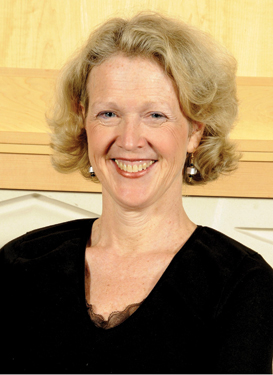Mindful Medicine
Pre-med students are accustomed to taking classes in chemistry, biology and physics, but Maryanna Klatt has them on a wider track, learning yoga and meditation. An associate professor in the College of Medicine at the Ohio State University, Klatt focuses on the health impact of chronic stress and ways to reduce it. She teaches medical school students and family medicine residents, but her pet project is designed for undergraduates.
Maryanna Klatt has them on a wider track, learning yoga and meditation. An associate professor in the College of Medicine at the Ohio State University, Klatt focuses on the health impact of chronic stress and ways to reduce it. She teaches medical school students and family medicine residents, but her pet project is designed for undergraduates.Klatt created and directs Integrative Approaches to Health and Medicine, an interdisciplinary minor that examines treatment of the whole patient—body, mind and spirit—including methods outside traditional Western medicine. “It’s really teaching the human side of medicine,” she said.
Courses review mind-body therapies such as Chinese acupuncture, herbal medicine, mindfulness meditation, neuromuscular massage, and chiropractic manipulation. Her students are the healthcare providers of tomorrow, preparing to become physicians, nurses, and therapists. “I love teaching in this program because I get these students at the undergraduate level , when they are more open to new ideas and not so focused on the science,” she said. “I think it will make a difference in how they treat their patients.”
Nearly a hundred are enrolled in a program designed for twenty-five to fifty undergraduates. Their interest reflects the public appetite for holistic, sometimes unconventional therapies. “When I’m on an airplane, I never tell people what I do because that’s all they want to talk about,” Klatt said.
Her instructional approach is as extraordinary as her subject matter. A teacher, researcher, and practitioner, Klatt begins each class with a meditation. She asks students to list three things for which they are grateful and to bring a healthful snack each day. “My own children make fun of me,” she said with a grin. “They say, ‘Do you mean you have snack time in college?’”
Students who enter as skeptics quickly become converts. “I show them the science, which makes the material hard to ignore. Everything taught is from an evidence-based perspective. The influence our minds have on our bodies is a real eye-opener for them, with the placebo effect being the best example.”
The National Institutes of Health has funded Klatt’s research into developing and evaluating programs—combining yoga, meditation, and music—at work sites and in schools to reduce the risk of stress-related chronic illness such as heart disease, depression, and sleep disorders. Her protocols offer modified versions of mindfulness-based stress reduction (MBSR), a program established in 1979 at University of Massachusetts Medical School to help hospital patients heal.
The National Center for Complementary and Alternative Medicine at NIH defines mindfulness as “focusing attention on present-moment experience and the nonjudgmental awareness of body sensations and emotions.” It is a way to identify stressors and alter perspective toward them. “We show people how to practice mindfulness, and there are exercises for that,” said Klatt, a certified yoga instructor trained in the mental technique. “Mindfulness can help people discern what is toxic to them and what is life-giving.”
Groups engaged in her research have reported lower feelings of stress and improved sleep quality. One study of inner-city third-graders identified better behavior through reduced hyperactivity. “We weren’t looking for that,” Klatt said. Measures of biological markers among study participants have revealed lower levels of stress hormones and inflammation linked to heart disease and some cancers. Klatt has published her data in several journals and presented her work at national and international conferences.
A mysticism class at Kenyon taught by Jewish studies professor Eugen Kullman piqued Klatt’s interest in the interconnection of body, mind, and spirit and sowed the seeds for her career. “It was not only what he taught, but how he lived,” she said of Kullman. “He was naturally mindful, and I knew that is what I wanted.” Taking a yoga class in graduate school at Ohio State also had a strong effect on her. “It was the first time I felt I was in my body, and that was a place I had not explored.”
Some people are naturally mindful. Klatt is not among them. It was something she had to learn and apply to her own stressful life as a political wife (her husband Bill is an appellate judge in the 10th District Circuit Court) and the working mother of three (Will, twenty-five, a labor organizer and community activist; Anna, twenty-three, a business consultant; and Joseph, twenty, a student at Indiana University). “I wonder if this is why I can effectively teach mindfulness, because I had to learn it myself,” she said. “It saved my life because it gave me the tools to deal with stress.”
—Dennis Fiely

 Delicious
Delicious Facebook
Facebook StumbleUpon
StumbleUpon Digg
Digg reddit
reddit